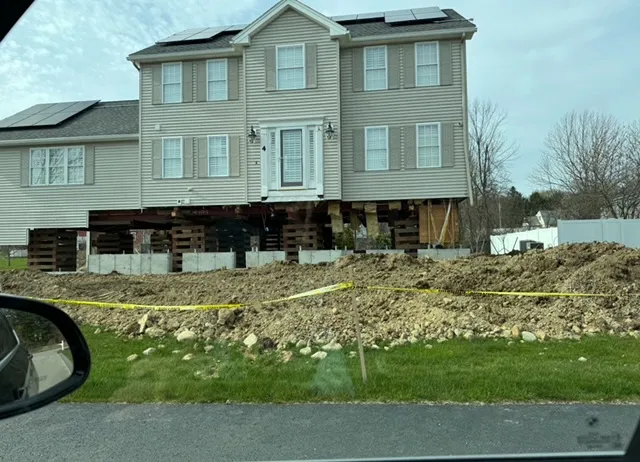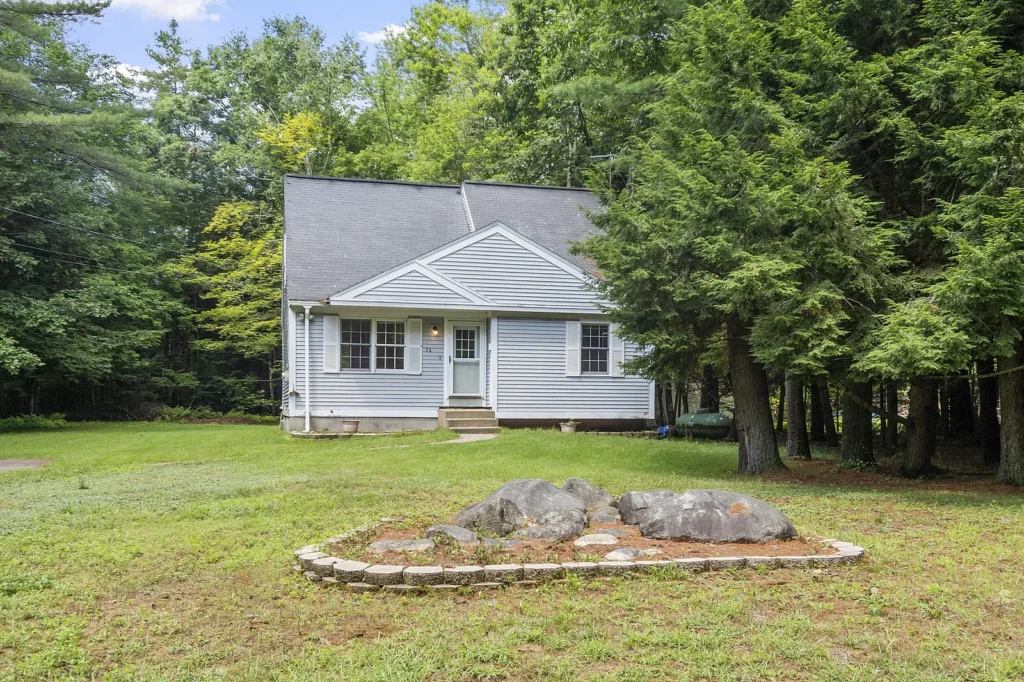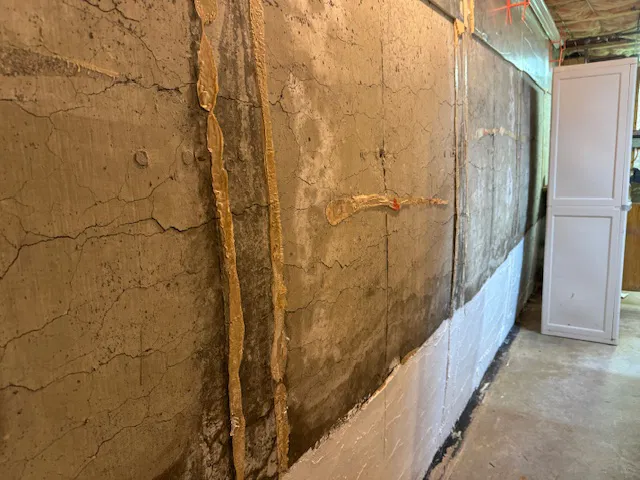
Sometimes the stars align. In this case, the subject matter is not a positive one–it is about crumbling foundations. However, the fact that pyrrhotite, which in my opinion is the scariest word in real estate right now, has a spotlight on it, aligns with a few things that have crossed my desk since last month’s newsletter.
First, a reader reached out with questions about pyrrhotite, since she had heard that there were homes in Central Massachusetts with crumbling foundations. This reader asked me to write about this huge problem that homeowners in many parts of Massachusetts are facing. If you haven’t heard of it, then you should have questions, too.
Second, it just so happened that I was already signed up for an information session about pyrrhotite, put on by the Realtor Association of Central Massachusetts. The presentation included a few panelists, including Dr. Jonathan R. Gourley, a professor from Trinity College in Connecticut, which has been at the forefront of the pyrrhotite issue for years now. Also on the panel were two affected homeowners in Massachusetts, Michelle Loglisci from Monson and Karen Riani from Holden, much closer to home for most of us.
Worcester Telegram clip featuring Michelle Loglisci
Spectrum News clip featuring Karen Riani
Worcester Telegram 2021 story featuring Karen Riani
Those of us who had heard of pyrrhotite assumed it was a Connecticut problem–any crumbling foundation problem I’ve ever heard of was related to real estate in Connecticut, or Massachusetts towns bordering Connecticut where crushed rock aggregate containing pyrrhotite is associated with a quarry in Willington, Connecticut. Why didn’t more of Massachusetts worry? Because a concrete truck can spin for only so long, and a house under construction in Rutland, Westminster, Holden, etc. wouldn’t likely be seeing a concrete truck that came from as far away as that. Then homeowners in Central Mass started going in to their basements and finding the telltale map cracking.
Third, and the huge bit of irony in this, I had already signed up for the class, I had already started writing the story, and then I got a call from a homeowner who asked me to help him sell a house in Winchendon “and it’s got the foundation problem”.

What is the foundation problem?
“The foundation problem” is that there are foundations that are crumbling in Central Mass, and the more awareness there is, the more towns that appear on the map. If you have enough pyrrhotite in your foundation, this destructive crumbling is unavoidable and irreversible, it’s not covered by your homeowners insurance and depending on the size of your foundation, could cost $150,000 – $250,000+.
What is pyrrhotite?
“Pyrrhotite (PEER-o-tight) is a naturally occurring iron sulfide mineral that is often found in marine sedimentary rocks. It can also can be found in some igneous rocks and some metamorphic rocks that are of a marine origin. It is a highly reactive mineral and breaks down in the presence of water and air. Pyrrhotite, even at low concentrations in concrete aggregate, is responsible for the premature crumbling of many concrete basements in northeastern Connecticut and south-central Massachusetts.
How does pyrrhotite in concrete cause cracking?
Pyrrhotite is an unstable mineral. In the presence of water and air, it transforms into secondary minerals that are larger in size. This space problem initiates cracking in concrete, provides further pathways for water and air to penetrate and eventually the concrete deteriorates. This deterioration can take years to decades depending on the quality of the initial concrete and environmental conditions.
Is pyrrhotite found in every concrete foundation?
No. We have tested many homes that are pyrrhotite free. The presence (or absence) of pyrrhotite depends on the rock aggregate in the concrete and where it was derived from geologically. Connecticut rocks have some formations that are more prone to higher levels of pyrrhotite than others, and there are many rock types used for concrete aggregate in which pyrrhotite is not present.” Trinity Concrete Analysis– FAQs about pyrrhotite
I’m not a scientist and until last week, I hadn’t seen pyrrhotite in person. For most of us, our home is our biggest asset. We improve our properties over time and most of us include the money from the eventual sale of our home in our future plans for how we will fund our retirement years. Listening to the personal stories of Michelle and Karen was a mix of heartbreaking and terrifying.
Michelle and her husband built their dream home and as part of their retirement planning, they paid off their mortgage in 20 years. They planned to eventually retire and sell their house to their son. As she explains in one of the videos above, Michelle happened to read a newspaper story about a crumbling foundation a few towns over from Monson, and the concrete company that supplied the concrete to that house was mentioned in the story. This is the same concrete company that Michelle and her husband had used in the construction of their home. Michelle went down to her basement–what she found and what she’s learned since then (they can’t sell their house to their son because no lender will finance a house with a crumbling foundation), and they can’t even refinance to come up with the funds to replace the foundation–prompted her to raise awareness and bring the issue to Boston.
When Michelle met Karen, who has a $260,000 foundation replacement story herself, she knew this would help bring much more awareness to the pyrrhotite issue. Because Karen’s house is in Rutland–these stories were creeping closer to Boston, where previously her efforts were brushed off as a Western MA problem. As a realtor when I see a house like Karen’s, I’m excited because it just shows pride of ownership, meticulous attention to keeping everything in tip top shape. AND it was only built in 2002–what could possibly be wrong with it, with seemingly such attentive owners? My notes from hearing Karen’s story are limited, because I stopped writing, to listen so intently. From memory–they had a small water issue in the basement that wasn’t able to be remedied by gutters. Karen’s husband was so bothered to have any moisture in the basement that he decided to pull down a wall where the basement had been finished space. When he pulled down that wall, built up against a foundation wall, was the beginning of their nightmare. Since then, they’ve had to completely replace the entire foundation, and refinance the house after the huge job was complete. So, now, heading in their retirement years, they now have a new mortgage–Karen noted that at least it was during the time when the interest rates were so low.
I encourage you to go to the Massachusetts Residents Against Crumbling Foundations website, and follow their Facebook page for updates. Their website lists testing companies and foundation replacement contractors as a courtesy. If you are considering hiring any contractor, you need to do your own due diligence.
“Massachusetts Residents Against Crumbling Concrete is a group dedicated to raising awareness and gaining support for solutions to the crumbling foundation crisis arising throughout homes in Massachusetts.” –MASSRACF

Foundation in Winchendon, MA
Pyrrhotite destruction is no longer thought to be concentrated in a limited geographic area, and it doesn’t discriminate between whether you live in a one bedroom cottage or a huge custom home.
There are a lot of unknowns related to which quarries used pyrrhotite in the aggregate that was sold to concrete companies. As of July 2024, there will now be required testing of materials in Massachusetts quarries. The Massachusetts Department Of Transportation will create a new department and licensure process to oversee quarries.
There are currently two methods for Identifying the presence of pyrrhotite in a concrete foundation. The visual inspection is pretty easy to spot if the problem has already shown itself. A huge wild card is the fact that they’re learning that the problem is showing up 20 to 30 years after the foundation was poured. So, a 20-year-old house may have a foundation that looks perfectly normal and a visual inspection shows nothing. Unfortunately, that doesn’t mean there is not a pyrrhotite problem.
A homeowner can have core sampling done, at a cost of approximately $2500 per sample. But I haven’t yet met a seller who wants to spend money to potentially prove their house is unfinanceable, and in many cases worthless. The only way to remedy a pyrrhotite problem, is to lift up the house and remove and replace the entire foundation. If you do test your foundation, Massachusetts has a reimbursement program for the testing.
Here’s a letter I wrote to our legislators immediately after attending the information session.
Hello–
I’m a Princeton homeowner and Realtor who works throughout Central Mass. Today I attended a forum for Realtors, put on by the Realtor Association of Central Mass, to educate us on the status of the crumbling foundations issue, show us the expanding map of affected areas throughout Massachusetts, and an update on the legislation.
Most people I work with in my professional capacity are buying or selling their largest asset ever. At this forum, we heard from Michelle Loglisci and Karen Riani, homeowners directly affected by crumbling foundations–both have suffered financially, to the tune of hundreds of thousands of dollars each, despite having done nothing other than working hard to achieve the American dream of homeownership. Both Michelle and Karen were hit with this ugly surprise as they neared retirement age.
I sold a house on William Circle in Rutland last summer. While out for a drive a few months ago, my husband and I happened to pass through the neighborhood and I was shocked to see the house across the street fully lifted in the air. Photo above of the 2,500 square foot home. Earlier this week I went on a listing appointment in Winchendon and before I met the seller he told me he had ‘the foundation problem’ (photo also above)…luckily for me, he already knew it was a $150K+ hit to the equity on the property, so I didn’t have to be the one to tell him. Imagine you live in a $325K home (a real price in Winchendon) and before you pay off your mortgage, you’ve got a foundation bill that exceeds 50% of the value of the property. This property is now for sale at basically 1/2 price and will require a cash buyer who is willing to take on the foundation replacement.
We need the Affordable Homes Act with the Crumbling Foundations Assistance Fund amendment to pass this session so Massachusetts can put an end to homes being built with pyrrhotite-laden concrete, and a funded foundation replacement program to help the real estate industry have faith in the homes we are helping people buy and sell. Please support the crumbling foundations assistance fund in the Senate version of the Affordable Homes Act.
Thank you
Jennifer Shenk, Princeton
Realtor, Keller Williams Realty North Central
Since I wrote the letter, there was a discovery in Dracut, MA that Winding Brook Condos, a 260 unit condominium development is affected by pyrrhotite. I’m sure this won’t be the last you hear of this issue, and I’m betting that you’ll be heading down to your own basement next.
Angry? Scared? Contact your legislators (find my legislators link here) and encourage them to keep fighting this battle. Unfortunately, despite the efforts of Michelle and Karen and so many more affected homeowners, relief for affected homeowners was cut from the Affordable Homes Act at the last minute.
SEPTEMBER 2024 Original Story
Pyrrhotite: The Scariest Word in Real Estate Right Now
JUNE 2025 Update
Crumbling Concrete Foundations in Massachusetts, caused by Pyrrhotite
JULY 2025 Update
Progress on the Crumbling Concrete Foundations Crisis



